2022 Espíritu de Montjuďc report
On a cold April day
Author
- Mattijs Diepraam
Date
- April 6, 2022
Related articles
- Barcelona - The Spanish spirit of racing, 2016 Espíritu del Jarama and 2017 Espíritu de Montjuďc report, by Mattijs Diepraam
- Estoril - Sunset on a season, 2017 Estoril Classic report, by Mattijs Diepraam
- Jérez - Sherry, sun and spectacular racing, 2021 Jerez Historic Festival report, by Mattijs Diepraam
- Portimăo - October rain, 2021 Algarve Classic Festival report, by Mattijs Diepraam
Who?Steve Hartley What?McLaren-Cosworth MP4/1 Where?Barcelona When?2022 Espíritu de Montjuďc |
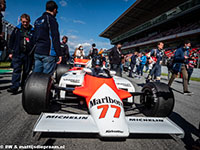 |
Why?
It was five years since Masters Historic Racing had featured in Barcelona’s early-spring Espíritu de Montjuďc meeting, so their return was highly anticipated. These are different times, however, and post-COVID, post-Brexit and in the midst of super inflation, the world is not looking good for British historic racers with ambitions to race on the continent. Add the fact that a ‘Monaco year’ is always difficult for other historic F1 races in its direct vicinity on the calendar, and it was no surprise that just 15 F1 cars turned up.
In fact, Masters brought just two of its five grids, having already wisely decided to spread out their series instead of offering them as a single package. Masters Gentlemen Drivers and Masters Pre-66 Touring Cars will now predominantly race in the UK, in some cases in stand-alone events, as 98% of their numbers is made up by British drivers, many of which are small-time enthusiasts for whom travel barriers have been adding up because of all the issues mentioned above. Its two most high-profile and ‘continental’ series, the Masters Endurance Legends and the now renamed Masters Historic Formula One series (rechristened Masters Racing Legends because of trademark licensing issues) will continue to travel the entire continent while its fifth grid, Masters Historic Sports Cars (now renamed Masters Sports Car Legends) will sit somewhere in the middle. In this case, it didn’t travel to Barcelona, not helped by the fact that Peter Auto contrived to schedule their Mugello Classic – with their rivaling CER1 and CER2 grids – on the same weekend.
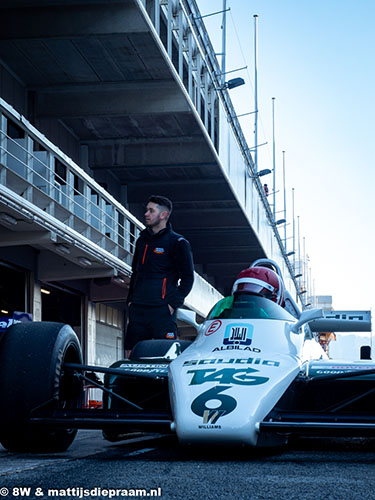
Lukas Halusa had swapped his McLaren M23 for a Williams FW08. (photo 8W)
The quality of the F1 grid was up to standard, though, with the series’ two main rivals of the past few years both traveling to Catalonia. Reigning champion Mike Cantillon’s presence with his Williams FW07C was a shoo-in but for Steve Hartley this was something of a novelty. For a few years now, ‘The Jam Baron’ had focused on the British rounds, but this year he was looking for a fresh challenge – with a Monaco participation and a new team, Hartley having swapped Mirage Engineering for Anthony Seddon’s operation. Dave Abbott had made the same switch with his Arrows A4, leaving Mirage with James Hagan’s Hesketh and ORECA-Nissan 03 and a realm of new opportunities that the team was relishing.
Hall & Hall still had the same customers, but each with new cars. The 2021 pre-78 class champion Lukas Halusa had stepped up to the ground-effect class with an ex-Keke Rosberg Williams FW08 – a 1982 car, not the flat-bottomed C-spec car that Mark Hazell has campaigned for years now, and has been made to look like the first F1 car that Ayrton Senna drove while testing at Donington in 1983 – because it was this particular chassis. Halusa’s title-winning mount, the ex-Mass McLaren M23, would go to brother Niklas, but due to business commitments the older Halusa would only do selected rounds in 2022. Meanwhile, octogenerian Michel Baudoin was still going strong, leaving his good old Hesketh 308E behind for a beautiful Rothmans-liveried March 821 – another ex-Mass car, in fact.

Still not thwarted by age - octogenerian Michel Baudoin found time for a new challenge in the shape of this ex-Jochen Mass March 821. (photo 8W)
Another newcomers included Mark Higson who joined Bob Blain and his March 761 at Nine-W Engineering with an ex-Niki McLaren MP4/1B, complementing Hartley’s ex-Wattie car. Cantillon and teammates Christophe d’Ansembourg (in a similar Williams FW07C and the Lola-Aston DBR1-2), Jonathan Holtzman (in the Tyrrell P34 sixwheeler continuation) and Jamie Constable (Pescarolo-Judd 01) had stayed where they were, but their team had been given a new name to signal a fresh start: Front Row Racing, fronted by brothers Alistair and Jay Bennett, with their father Colin taken ill and sadly no longer actively involved in the team.
Hartley stunned the competition and himself by taking pole – and again when he led the first from start to finish, allowing Cantillon no closer than seven tenths. At one time in the race, Halusa looked poised to usurp the two of them, setting fastest lap of the entire race on lap 6 and putting the FW08’s stubby nose underneath the FW07C’s gearbox but two laps later the Austrian was seen drifting away from the two leaders, having cooked his tyres. D’Ansembourg finished a distant fourth, ahead of Steve Brooks who had stuck with his Lotus 91, and Hazell in the FW08C.
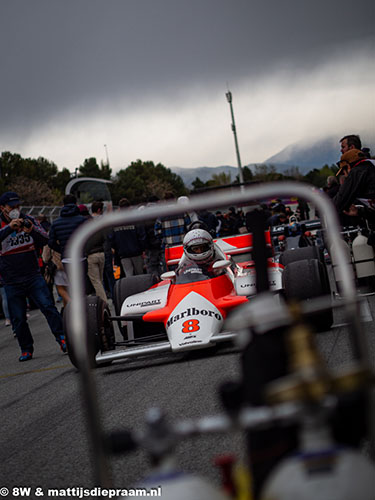
Mark Higson's new mount - an ex-Lauda MP4/1B - looked resplendent on the grid. (photo 8W)
In seventh overall, Patrick d’Aubréby had an easy time of it – he himself frankly admitted so – on his way to the first of two pre-78 class wins. On Saturday, his ex-Bleekemolen March 761 was followed home by Hagan’s Hesketh, with Peter Williams debuting his Lec CRP1 with third in class. The next day, with Hagan not present, Williams duly took second but only after Jonathan Holtzman was penalised with a drivethrough penalty for jumping the start.
Sunday’s race was all the more dramatic at the front. From the reversed grid for the first five of the first race, D’Ansembourg soon waltzed past Brooks for the lead, and the Belgian looked in control, even after Cantillon, Halusa and Hartley all followed through and kept a close guard. But then the spits of rain at the start became a fair drizzle, certainly at the back of the circuit, and D’Ansembourg – as the leader having to tread his way in unchartered territory – was the first to spin. Cantillon took avoiding action and was only barely able to keep Halusa behind, but the Austrian pulled a sneaky move in the corner before the final chicane. That proved just in time, as two corners later the safety car was called – Brooks was the second one to have lost it, and on this occasion the spinner was off with damage.

Mark Hazell had given his ex-Senna FW08C the final touches that it needed, including the 'Save The Children' with which this chassis ran on the day Ayrton made his F1 debut in that famous Williams test at Donington. (photo 8W)
The safety car remained at the head of the field until the chequered flag, so Halusa was flagged off as the winner – so a first overall victory in his first weekend of trying. It continued the remarkable progress Halusa made during 2021, which not only handed him a truly dominant pre-78 class title, but also saw him excel in the Historic Grand Prix Car Association races, particularly during that wet late-season Algarve Classic Festival where he hauled his pre-war Bugatti onto the overall podium.
Masters Endurance Legends would only see one race, and it was split in two sections of a very different character. The first half of the race was spent almost entirely behind the safety car, as Jamie Constable’s Pesca proved very hard to free from the gravel trap in which in got beached on the first lap. Race direction was forced to red flag the race, with the break now effectively acting in lieu of the pit window. Steve Brooks, who had acquired one of Steve Tandy’s Lola B12/60s – the Mazda-engined one – shared the car with OC Racing team boss Martin O’Connell, and the latter soon blitzed his way to the front as soon as the second part of the race got going. Winning on the road, O’Connell still had to serve his 20-second ‘elite driver’ time penalty, and with the mandatory stop having effectively disappeared with the break forced by the red flag, there was no other alternative than to hand him the penalty at the end.
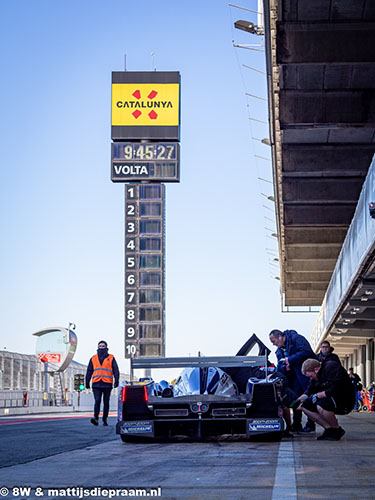
Steve Tandy's old campaigner, the Lola-Mazda B12/60 powered by an AER 2-litre four-pot turbo, was acquired by Steve Brooks to go up against Tandy's new Judd-engined ex-Dyson machine. (photo 8W)
This dropped him to fifth place, which meant that the duel between D’Ansembourg and Kriton Lendoudis in the Peugeot 908 had been the actual race for the win. The Belgian had surged past the diesel-engined machine in the early stages after the restart, but failed to shake it off. Towards the end, Lendoudis came ever closer and reckoned he had needed one more lap to pull off the pass, but it wasn’t to be for the Greek. He was unhappy about it but his revenge would come later in the day.
Except that it wouldn’t. In the dying stages of the second race of the local Copa Racer series for Mini Cooper cars, one of the Coopers’ engines had let go in spectacular fashion, and the driver had done the unwise thing of continuing for five more corners before pulling off. This left an oil trail that was as long as the entire second timing section of the circuit, and especially at turns 5 and 6 conditions were atrocious, not helped by the rain now dispersing the oil across an even wider surface.
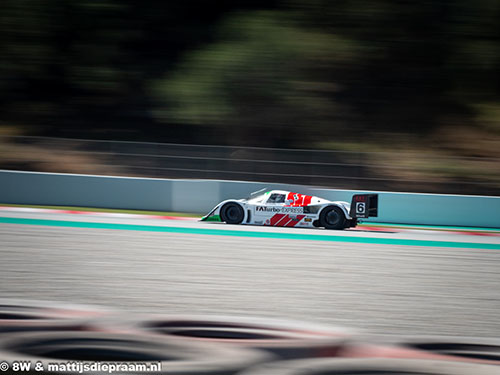
A welcome guest - Lukas Halusa brought his Porsche 962 to the Masters Endurance Legends grid. (photo 8W)
It was shades of the Algarve, since the 2021 Algarve Classic Festival had suffered from an identical issue that had taken an hour and a half to sort. On this occasion, the delay was even worse – in total amounting to two hours, and the second Masters Endurance Legends race was forcibly cancelled. Pro driver Aaron Scott – sharing Rick Carlino’s new ORECA-GM FLM09 LMPC-class car – went out to inspect the affected section and reported that people were ‘unable to walk’.
Only much later did the second Iberian Historic Endurance race and the third Copa Racer race take their course. One Antonio Albacete won the latter, as he had done in the first race – but it was not the former F3000 driver and FIA European Truck Racing star that had done the business nor his father who was a prominent Spanish racer in the sixties and seventies. No, here was Antonio Albacete III doing his thing, the third-generation driver proving equally adept to driving cars very fast.
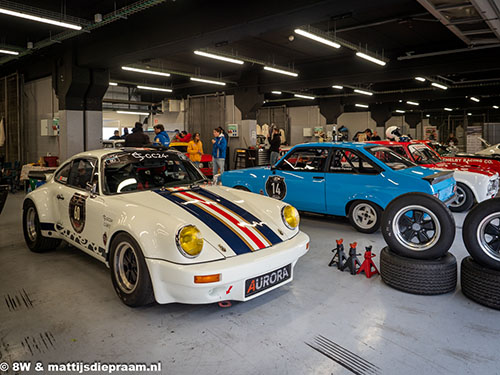
A three-time winner on the weekend: Pablo Bastos Rezende won every race he took part in. (photo 8W)
In the three races promoted by Diogo Ferrăo’s Race Ready organisation – the two Iberian Historic Endurance races and the Carrera 80s race for eighties sportscars and touring cars – Portuguese driver Pablo Bastos Rezende took a clean sweep in his Porsche, winning all three of them.
